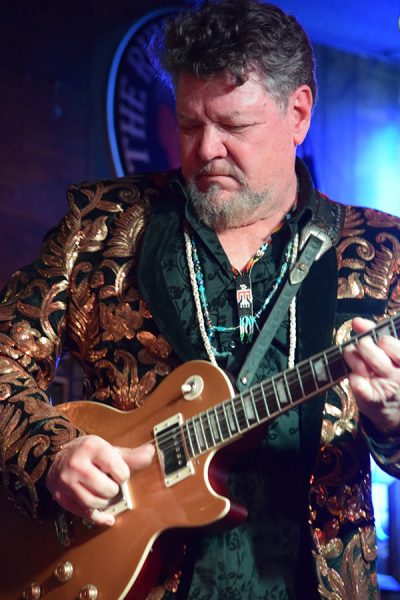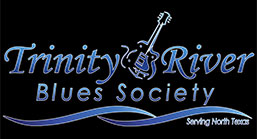Musicians Corner Feature-James Hinkle
Artist Bio: Throughout James Hinkle’s life, art and music have enjoyed equal importance in his attention, and since decamping from Fort Worth to Austin in the early ’80s, he’s pursued parallel careers as a visual artist and musician.
“To have a rich life,” the accomplished painter-guitarist-singer-songwriter-bandleader says, “you’ve got to immerse yourself in something other than yourself.” It’s a philosophy he gleaned from his father, James T. Hinkle, a humanitarian and stalwart Lions Club member who served as mayor of Lake Worth. The elder Hinkle taught his son to stand up to local bigots and nurtured his creativity, allowing him to miss church to see the Beatles on the Ed Sullivan Show and enrolling young James in art lessons at the Fort Worth Children’s Museum when he showed an early interest in drawing.
Having caught the music bug, Hinkle learned guitar and started writing songs, inspired by singer-songwriters like Neil Young, until a coworker, guitarist Freddie Cisneros, introduced him to the vibrant blues scene that, in the mid-’70s, still existed in Fort Worth’s Black community. Following Cisneros into east side clubs and the famous New Bluebird Nite Club on Horne Street, Hinkle learned the music and, more importantly, “respect for the culture that created it.” Black blues clubs, Hinkle explains, were more than just businesses. They were, he says, “community hubs where people brought food and gathered to celebrate each other.”
It was Cisneros who pushed Hinkle onstage at the Bluebird with the injunction, “Play rhythm guitar!” Fort Worth blues icons like singer-drummer-Bluebird proprietor Robert Ealey and guitarist-singer U.P. Wilson welcomed the youngster onstage and schooled him in their aesthetic and world view.
Meanwhile, Hinkle’s art studies continued through private painting lessons and earning an associate’s degree at what was then Tarrant County Junior College. At TCJC, art instructor Eduardo Aguilar recognized Hinkle’s potential and urged him to put together a portfolio for submission to the studio art program at the University of Texas in Austin – a city which Hinkle was already visiting regularly as a participant in the exploding blues scene there.
At UT between 1981-84, Hinkle worked closely with the Thai sculptor Thana Lauhakaikul, spending many hours assisting his mentor with a Vietnam veterans’ memorial at Lauhakaikul’s South Congress studio. “He’d had success in Thailand and given away all his money when he emigrated to the US,” Hinkle says. “Here, he achieved success, but lost everything when his studio was destroyed by fire. He saw that as karmic retribution.”
Away from the classroom and the studio, Hinkle fronted an R&B horn band, Tempest, which evolved into the ska-reggae-bluebeat outfit Housewives Choice under the influence of some ethnomusicologists and West Indians in the lineup. Post-graduation, Housewives Choice downsized to a three-piece Texas rock band. Hinkle went on to learn New Orleans rhythm as a member of pianist-singer Marcia Ball’s touring unit. Back in Fort Worth, he teamed up with singer-rubboard player Johnny Mack, occasionally collaborating with partners like Austin harmonica ace Ted Roddy and Joe Ely’s accordionist Ponty Bone.

With the arrival of the new century, Hinkle made a series of recordings that showcased his depth and versatility as a musician. On Straight Ahead Blues, Blues Now Jazz Later, and Some Day, he demonstrated that he was as comfortable with down-home shuffles, second line groove, jump blues, swing, II-V-I changes, and soulful balladry. He was emerging as an elder on the Fort Worth music scene, playing all kinds of rooms to all kinds of audiences, hiring younger musicians and teaching them the proper rhythm and attitude to play classic styles he’d learned from masters.
During this period, Hinkle’s visual art went on the back burner, until a two-week rainstorm in 2006 got him back to drawing and painting. His mother-in-law – for he’d married attorney Betsy Parmer, whose father Hugh served as state legislator, Forth Worth city council member and mayor – brought him some acrylic paints, which he immediately used to paint a friend’s chickens nesting in trees.
An eye for the incongruous and an ability to find subject matter in his environment garnered Hinkle some commissions. The fiery destruction of State Fair of Texas icon Big Tex inspired a painting that brought a lot more attention to his art when it was exhibited at downtown Fort Worth’s Milan Gallery, owned by a couple of Hinkle’s childhood friends.
In 2015, Hinkle undertook a project he dubbed 8×10 4 365, in which he created an 8×10 painting every day for a year. “You have to move paint every day,” he says. At any given time, he’ll have four or five canvases in progress; when a commission comes, he’ll use one of them as the starting point. “I’m influenced by the Impressionists,” he says. “I like to work with color, texture, form. All of my works start out abstract. I like layered effects with a natural flow, no intent.”
On May 1, 2016, Hinkle suffered an aortic aneurysm, underwent surgery, and received a mechanical heart valve. During the recovery process, he suffered depression, and contemplated selling all his musical equipment. (It was a tough blow for the former marathoner to learn that the only forms of exercise he was allowed were swimming and walking.) A call from bassist Lee Allen to make a gig started Hinkle on the road back.
Today, Hinkle’s a regular presence on stages around town with collaborators like Johnny Mack, singer-guitarist Hank Hankshaw, harmonicist Gary Grammer, guitarist Darrin Kobetich, one man cover band Big Mike Richardson, and his daughter, singer Claire Hinkle. He’s learned to read and write music, and is constantly working to develop his ability, which he calls “the connecting thread.” He works on his visual art daily, and is currently affiliated with Tilt Vision Art Studios on the near south side.
Having looked death in the face has given Hinkle a finer appreciation for his life and the opportunities he enjoys to be expressive and share his gifts with others. His parallel careers are intertwined now, and the unity bodes well for a fulfilling and meaningful future.
